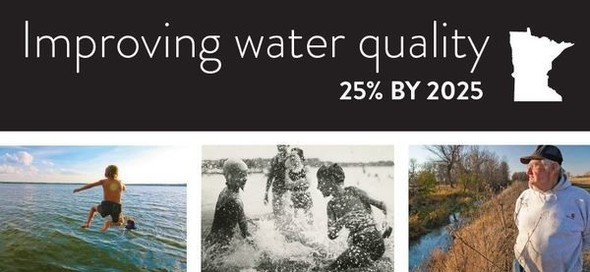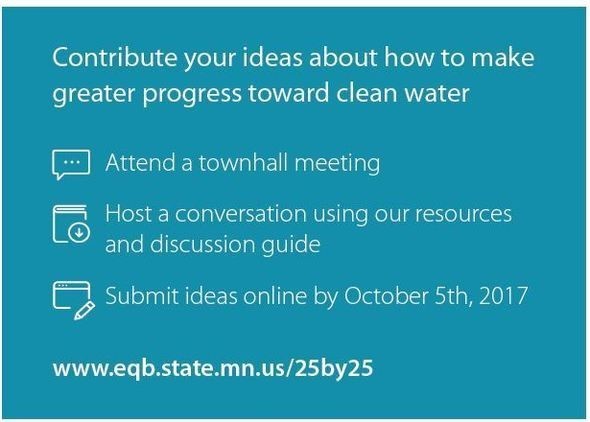
Britt Gangeness manages the Living Green 365 newsletter and she recently wrote the following article:
Minnesota
has a very unusual geographic position. We sit atop a triple,
continental-scale water divide. Almost all of our water arrives as rain or
snow. We have some very high quality waters, but Minnesota also faces some
serious challenges.
Nitrate in groundwater is a
growing concern
Three out of four Minnesotans
get their drinking water from groundwater sources, but groundwater is
threatened by overuse and contamination in some places.
Nitrate is one of the most
common water pollutants in Minnesota groundwater, affecting a large number of
private wells and public water supplies. Elevated nitrate in drinking water
can be harmful to human health, specifically to the health of infants. Septic
systems, fertilizers, and manure are major sources of nitrate pollution in
Minnesota.
40% of lakes and streams are
not good enough for swimming and fishing
Statewide, 40% of the lakes and
streams in Minnesota are not meeting standards set for safe swimming,
fishing, or drinking. In the northeastern part of the state, a higher
percentage of lakes and streams meet water quality standards, compared to
central or southern regions.
Water quality in a body of
water depends a lot on the land around it. In watersheds dominated by
agricultural and urban land, half or fewer of the lakes fully support the
water quality standards for swimming due to contaminants from runoff and
drainage.
Runoff in urban areas and
drainage from agriculture fields move water into streams and rivers quickly,
increasing the speed and volume of water in streams and rivers. Sometimes
these flows bring pollution that might otherwise be removed by wetlands or
other landscape features.
Our water infrastructure is
aging
Our infrastructure is badly in
need of attention. Water systems are aging. Many equipment and pipes are
at the end of or past their expected life span. Over the next 20 years,
Minnesota will have some big bills to pay to upgrade wastewater and drinking
water infrastructure. We will need to decide how to equitably pay for these
costs.
Water
issues vary by region
Water quality issues vary by
region depending on geology, land use, and other factors. You can find more
details about water quality issues near you in these information packets.
-
Northwest Minnesota: Becker, Clay, Grant, Kittson, Mahnomen, Marshall,
Norman, Otter Tail, Pennington, Polk, Red Lake, Roseau, Traverse, and
Wilkin counties.
-
West Central Minnesota: Big Stone, Chippewa, Douglas, Kandiyohi, Meeker,
Morrison, Pope, Stearns, Stevens, Swift, and Todd counties.
-
Northeast Minnesota: Aitkin, Carlton, Cook, Kanabec, Lake, Mille Lacs,
Pine, and Saint Louis counties.
-
Metro Minnesota: Anoka, Carver, Chisago, Dakota, Hennepin, Isanti,
Scott, Sherburne, Washington, and Wright counties.
-
Southwest Minnesota: Cottonwood, Jackson, Law Qui Parle, Lincoln, Lyon,
Murray, Nobles, Pipestone, Redwood, Rock, and Yellow Medicine counties.
-
South Central Minnesota: Blue Earth, Brown, Faribault, Le Sueur, McLeod,
Nicollet, Renville, Sibley, Waseca, and Watonwan counties.
-
Southeast Minnesota:Dodge, Fillmore, Freeborn, Goodhue, Houston, Mower,
Olmsted, Rice, Steele, Wabasha, and Winona counties.
-
North Central Minnesota: Beltrami, Cass, Clearwater, Crow Wing, Hubbard,
Itasca, Koochiching, Lake of the Woods, and Wadena counties.
What do you hope the water is
like in 2025?
At the current level of effort,
there will be only a 7 percent improvement in water quality statewide by
2025, and without further action, water quality will get worse. That's why
Governor Mark Dayton is calling on Minnesotans to learn about these issues
and share their ideas with him for '25 by ‘25' Water Quality Goals, which
would spur collaboration and action to improve Minnesota’s water quality 25
percent by 2025.
Get involved!

Breweries, distilleries, wineries and cideries are expanding at an unprecedented rate in Minnesota, with no slowdown in sight. MPCA staff want to make sure that these facilities and their consultants are aware that this industry sector may be required to comply with certain environmental regulations, including:
MPCA’s Small Business Environmental Assistance Program staff offer this list of requirements that may be applicable for facilities on their Brewing and Distilling web page.
This website also offers information about environmental sustainability and conservation, a topic that is applicable to all 29 industrial sectors, plus, greening your business, facility/building conservation for energy, water, and waste, funding opportunities for small businesses including grants and loans.
The page emphasizes water and energy reduction practices: Reducing waste = saves money. Though some of the content is brewery/distillery-specific, there are practical tips and suggestions that are applicable to many types of industries that manufacture products or recycle waste.
If you are a small business and want free confidential regulatory or waste reduction assistance within any industry sector, please visit the Small Business Environmental Assistance Program website or call technical staff at: 651-282-6143 or 800-657-3938.
|